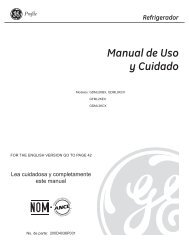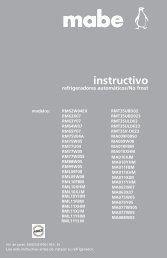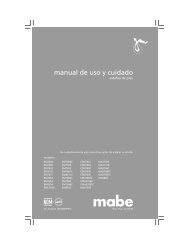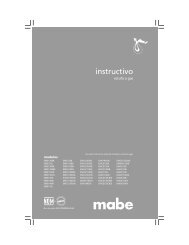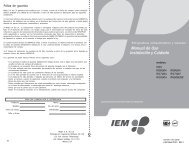Instructivo - Mabe
Instructivo - Mabe
Instructivo - Mabe
You also want an ePaper? Increase the reach of your titles
YUMPU automatically turns print PDFs into web optimized ePapers that Google loves.
38<br />
1<br />
2<br />
Caring for your refrigerator<br />
We recommend storing food in containers with lids, wrapped in or<br />
stored in air light materials such as aluminum foil, plastic containers or<br />
plastic wrap.<br />
Do not store hot foods in the fresh food compartment or freezer. You<br />
should wait until they have cooled down to room temperature.<br />
Only open the doors for the time necessary to store or remove food<br />
items or drinks. By doing this you will reduce energy consumption and<br />
improve the performance of your refrigerator.<br />
It may be difficult to open the door again after having opened and<br />
closed it to introduce or remove foods. This is normal due to the vacuum<br />
that forms in the interior of the refrigerator caused by the exchange of<br />
air at different temperatures. If this happens, wait 10 to 15 seconds<br />
before trying again and the doors should open easily.<br />
Always store onions in a plastic bag or a hermetically-sealed container<br />
to prevent their odor from penetrating other foods.<br />
Do not store garlic inside your refrigerator as a cold, dark environment<br />
promotes its germination. Store foods in small quantities in the freezer<br />
as this facilitates quicker and more effective freezing.<br />
We recommend placing food that you would like to freeze rapidly or ice<br />
cubes on the freezer shelf.<br />
Always take note of the manufacture’s expiring date on frozen<br />
products.<br />
Once food has been defrosted, it cannot be frozen.<br />
Liquids increase in volume when frozen. For this reason, do not fill<br />
recipients up to the brim with liquids.<br />
Do not store closed glass recipients containing liquids in the freezer.<br />
Cleaning your refrigerator<br />
Always disconnect the refrigerator plug from the outlet before<br />
cleaning or starting a technical revision.<br />
1) Never use toxic products (ammonia, etc), abrasive products<br />
(pastes) or fibers as they can damage the refrigerator.<br />
Use a soft sponge or a cloth, which has been soaked in water and<br />
a mild soap. Rinse and dry with a clean, dry cloth. You can also use<br />
a solution of one spoon of bicarbonate of soda and two litters of<br />
warm water to clean the interior.<br />
Do not use fibers or sharp or pointed objects which can scratch<br />
your refrigerator or the interior shelves.<br />
2) To clean the condenser ( on the models which have them), use<br />
a brush, cloth or sponge to eliminate accumulated dust. Do this at<br />
least every six months..<br />
During the cleaning, do not let accumulated liquid filter into the<br />
interior or the refrigerator as this could damage the unit. Dry well.




